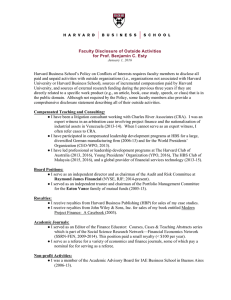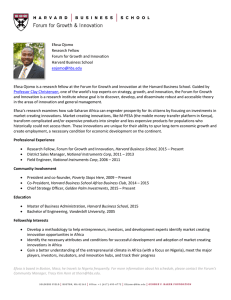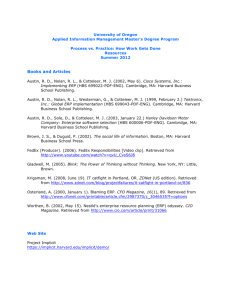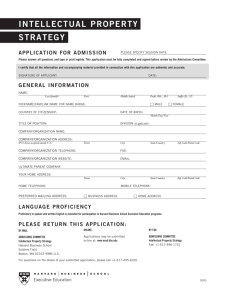FROM DEAN NOHRIA JAN 2014
advertisement
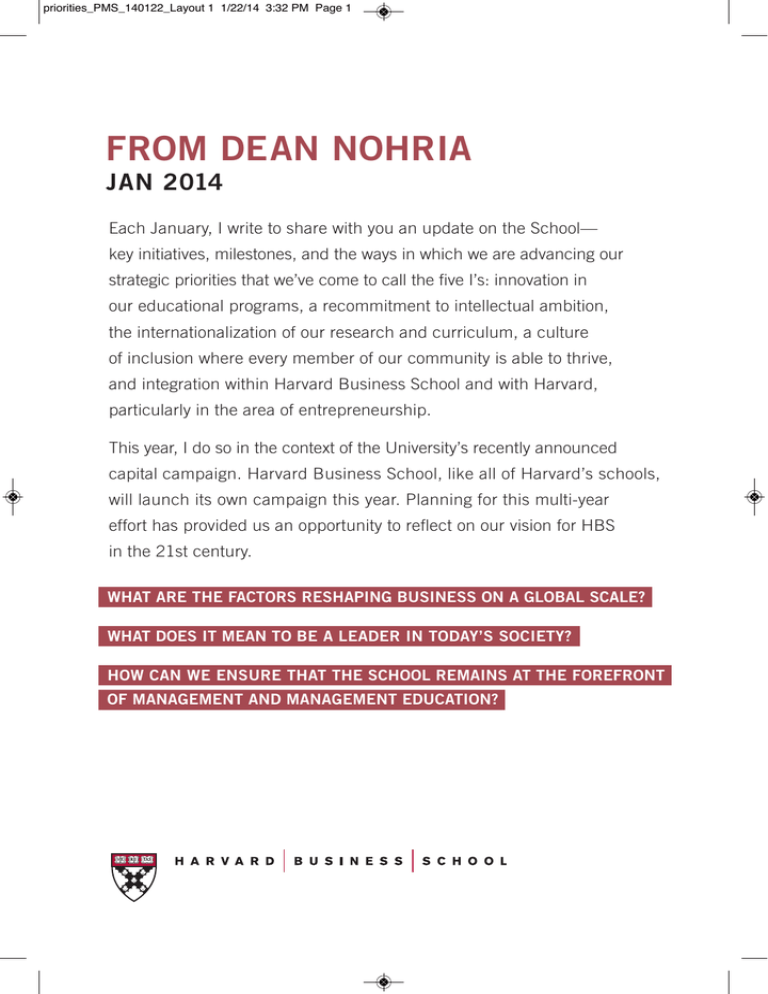
priorities_PMS_140122_Layout 1 1/22/14 3:32 PM Page 1 FROM DEAN NOHRIA JAN 2014 Each January, I write to share with you an update on the School— key initiatives, milestones, and the ways in which we are advancing our strategic priorities that we’ve come to call the five I’s: innovation in our educational programs, a recommitment to intellectual ambition, the internationalization of our research and curriculum, a culture of inclusion where every member of our community is able to thrive, and integration within Harvard Business School and with Harvard, particularly in the area of entrepreneurship. This year, I do so in the context of the University’s recently announced capital campaign. Harvard Business School, like all of Harvard’s schools, will launch its own campaign this year. Planning for this multi-year effort has provided us an opportunity to reflect on our vision for HBS in the 21st century. WHAT ARE THE FACTORS RESHAPING BUSINESS ON A GLOBAL SCALE? WHAT DOES IT MEAN TO BE A LEADER IN TODAY’S SOCIETY? HOW CAN WE ENSURE THAT THE SCHOOL REMAINS AT THE FOREFRONT OF MANAGEMENT AND MANAGEMENT EDUCATION? priorities_PMS_140122_Layout 1 1/22/14 3:32 PM Page 2 The process of creative destruction that Joseph Schumpeter described in his seminal Capitalism, Socialism, and Democracy more than 70 years ago, a “process of industrial mutation that incessantly revolutionizes the economic structure from within, incessantly destroying the old one, incessantly creating a new one,” continues to reshape business today, and is what makes this moment both exciting and challenging. AN ERA OF GLOBALIZATION, in which emerging economies are rapidly joining the global marketplace, is enabling a better way of life for billions of people. This presents unprecedented opportunities for growth, but it also makes competition for these opportunities ever more fierce. To be relevant, Harvard Business School must educate leaders to compete and succeed in this new arena. SIMILARLY, TECHNOLOGY CONTINUES TO BREAK DOWN BARRIERS of every type, from physical to political. Information technology creates new opportunities in social media and mobile; in life sciences, it is stem cells and personalized medicine; in energy, it is shale gas and solar panels; in manufacturing, it is nanomaterials and 3-D printing. These technologies and others will be disruptive for some firms and industries and beneficial for others. Thriving in such a technologically dynamic economy will require Harvard Business School to cultivate in its students an entrepreneurial mindset, whether they work in an established company or a start-up. THE RELATIONSHIP BETWEEN BUSINESS AND SOCIETY, TOO, IS CHANGING. Society is ever more reliant on business, and business increasingly is being called upon to address social issues that previously were in the public realm—from environmental sustainability to access to clean water, quality education, and basic health care. Yet society is quick to criticize business for failing to meet an ever-expanding list of social and moral obligations. 2 priorities_PMS_140122_Layout 1 1/22/14 3:32 PM Page 3 WE MUST EDUCATE LEADERS WHO UNDERSTAND THEIR RESPONSIBILITIES TO SOCIETY, AND WHO CAN STRENGTHEN THE PUBLIC’S TRUST IN BUSINESS. We also need to educate leaders who can bring a business perspective to the social sector, be it as social entrepreneurs or as volunteers and trustees. Our students must be prepared to provide leadership not just in their companies, but in their communities and countries as well. As we prepare for these forces of creative destruction and others that lie ahead, we must first reinforce what has allowed us to prosper over our first century: providing a transformational learning experience for the students and participants who come to our campus to study, developing a deep understanding of management practice that leads to novel thinking and breakthrough research, and disseminating our ideas and curricula to an expanding audience worldwide. We must reaffirm the core characteristics that define and distinguish Harvard Business School, from the case method and participant-centered learning to our unique residential campus. At the same time, WE MUST COURAGEOUSLY SEEK OUT INNOVATIVE WAYS OF DELIVERING ON OUR MISSION — exploring, for example, how we might make field-based learning a powerful complement to the case method or how we might leverage an online educational platform to deliver on the promise of lifelong learning. Let me outline for you now our efforts in each of the School’s five strategic priority areas, and how we’ve brought to bear this approach of reinvesting in our strengths while simultaneously exploring new paths and opportunities. 3 priorities_PMS_140122_Layout 1 1/22/14 3:32 PM Page 4 INNOVATION IN OUR EDUCATIONAL PROGRAMS In fall 2011, we launched Field Immersion Experiences in Leadership Development (FIELD) in the Required Curriculum of the MBA program. This yearlong course comprises three modules and aims to teach students how to develop their leadership, global, and integrative intelligence through a series of team-based simulations, exercises, and projects— what we call the “doing” and “being” of leadership. In FIELD 1, students learn how to form and Finally, in FIELD 3, students are charged work effectively in teams, how to give and with launching a microbusiness in ten weeks. receive feedback, and how to enhance their Their goal is not just developing a business personal leadership style. plan, but executing on a business idea that a customer can experience and will pay for. In FIELD 2, each of 150 student teams is matched to a global partner organization and asked to develop a new product or service concept (e.g., how a bank in Malaysia might introduce mortgage loans to Gen Y-ers unaccustomed to saving or home ownership). During the fall semester, teams work for eight weeks to develop a recommendation; then, for two weeks in January, they travel to their global partner location in cohorts of eight to nine teams, led by a faculty member and two HBS staff members. In country, student teams conduct firsthand market research, meet with company representatives, and refine their ideas, culminating in presentations to the global partner’s senior management and to their cohorts and faculty member. FIELD 2 helps our students develop contextual humility—a visceral awareness that their best ideas developed in Boston must be adapted to respond to the on-the-ground realities of their partner company and country. 4 Students learn, in the process, the difficulty of translating even a simple idea into practice, especially when working with team members of varying skill and motivation, vendors who may be more or less reliable, and customers with their own views of what they want as opposed to what one wants them to buy. Throughout, students get feedback from potential investors via a financial simulation that has teams in one section investing in the companies of a partner section. priorities_PMS_140122_Layout 1 1/22/14 3:32 PM Page 5 FIELD has been an ambitious undertaking for In the Doctoral Programs, building on the the School, requiring us to overcome a host findings of an intensive self-study in 2011– of execution challenges in support of this new 2012, we have instituted a handful of new field method of learning. From coordinating requirements. To build a stronger sense of vaccinations and visas for FIELD 2 to creating community and cohort, we now have a single 150 limited liability corporations for FIELD 3, start date in the summer and a shared orien- we ourselves are learning by doing. We now tation experience. We have introduced a Doc- are in year three of this endeavor and con- toral Methods and Theory course, providing tinue to refine and reshape elements of the training in research methods to support schol- course, building on experience and feedback arship. In January 2013, we launched Busi- from our students. In my conversations with ness Education for Scholars and Teachers students today, what is remarkable is how (BEST) Foundations, a fully integrated course quickly FIELD has become an integral and for our PhD and DBA students that helps valued component of the curriculum. Although them understand the language of business the evidence is as yet anecdotal, we also have and provides them a general management heard that FIELD is becoming a distinguishing perspective. Across all these initiatives, our feature of the School for potential applicants, aim is to produce scholars who are distinctly and that employers value the skills and expe- prepared to make a difference in the world riences students are gaining. through rigorous research that influences practice. With this work well underway, we are turning our attention to the Elective Curriculum, exploring how we might ensure both that it incorporates elements of the field method that have proven so effective in the Required Curriculum, and that it is a second year worthy of a two-year MBA program. innovation continues → 5 priorities_PMS_140122_Layout 1 1/22/14 3:32 PM Page 6 In Executive Education, we are especially ex- And in summer 2014, we will begin renova- cited about a number of new buildings taking tion of Baker Hall, renaming it Esteves Hall shape on the eastern edge of Soldiers Field. when it is finished in recognition of a gift from André Esteves. The renovation will bring The first, Tata Hall, dedicated in December 2013, is a state-of-the-art facility with 179 bedrooms, 2 classrooms, living group spaces, and program staff offices. The result of a generous gift from Ratan Tata, Tata Hall will welcome participants from around the world who we hope will have as transformative an experience as Ratan Tata did, enabling them to further develop as leaders who can enhance their organizations and their communities. In April 2014, we will break ground on the Ruth Mulan Chu Chao Center, a new facility that will serve as a gateway to the School for the 10,000 executives who attend classes here each year and as a vibrant hub that will connect them to the faculty, students from the MBA and Doctoral Programs, and broader HBS and Harvard communities. The Chao Center, part of a remarkable gift from the Dr. James Si-Cheng Chao and Family Foundation that also provides fellowships to MBA students, will be built on the site where Kresge Hall now stands and will open in 2016. It was especially fitting to receive this gift during our yearlong celebration of 50 years of women in the two-year MBA Program, as four Chao daughters—Elaine, May, Grace, and Angela— attended Harvard Business School. 6 the executive residence hall up to date in its fittings and furnishings. Cumulatively, when completed, this work will provide long-needed capacity, given the maturity and depth of our executive programs, and will support such innovations as experiments in blended learning that leverage content and materials from our Publishing group, and a review of and enhancements to our flagship Advanced Management Program. Even as we innovate in our educational programs, we have stayed true to our commitment to participant-centered learning, which requires students to engage with and learn from one another. We have remained focused on learning that starts with real problems in business, whether it be through case studies or field studies. We continue to help our students hone their competence to make judicious decisions and their character to act with authenticity and integrity. Our campus and curriculum enable students to form enduring relationships with each other. priorities_PMS_140122_Layout 1 1/22/14 3:32 PM Page 7 We are now exploring whether we can bring Key elements of an HBX initiative have begun these same principles to an online learning to take shape. In the first phase, which we platform we are calling HBX. Given the enor- will launch during the coming year, we are mous opportunities and potential threats we developing: see in the technological innovations that are reshaping education, we think it is vital for HBS to enter the online arena. Our work is guided by the view that our efforts must complement and enhance our on-campus offerings, must elevate our reputation for excellence and impact, and must expand the reach of the School, all consistent with and supportive of our mission. • A suite of courses (including financial account- ing, economics for managers, and business analytics) designed to prepare college undergraduates for their first post-college job, and to prepare matriculating MBA students with the basic toolkit they need before beginning an MBA program—in other words, content that provides comfort and facility with the basic language and tools of business. • A virtual, technology-enabled classroom that allows individuals—alumni or Executive Education participants, for example—to interact with one another and a professor as they would in person on the HBS campus. In phase two, beginning in the fall, we envision adding “franchise courses,” making some of the most popular courses at the School accessible to a wider audience of students and alumni beyond those we can reach on campus. We also are exploring what opportunities HBX might offer in the area of entrepreneurship and innovation. Across all these projects, we are working on a platform and user interface that will create a truly transformational learning experience. We want HBX to be as distinctive and outstanding as any other HBS activity or program. 7 priorities_PMS_140122_Layout 1 1/22/14 3:32 PM Page 8 A RECOMMITMENT TO INTELLECTUAL AMBITION It has been a century since the Bureau of Business Research (now the Division of Research, or DOR) issued its inaugural bulletin on shoe retailing, building on input from more than 600 shoe stores and with a circulation of 10,000 copies. In defining a uniform system of accounting, Cross-disciplinary research has flourished the study was the first organized effort to ad- in recent years, too. For instance, the U.S. vance knowledge and practice in the field of Competitiveness Project, launched in 2010, management. Today, the DOR supports a is a multiyear effort to understand and im- range of initiatives and projects at the School, prove the competitiveness of the United spurring both individual work and collabora- States—that is, the ability of firms operating tion across disciplines to address the most in the United States to compete successfully difficult management challenges of our time. in a global economy while supporting high What distinguishes research at HBS? First and foremost, it is problem focused and aims to influence management practice. Faculty members conduct academically rigorous study and rising living standards for Americans. The project focuses especially on the roles business leaders can play in promoting U.S. competitiveness. using a broad range of methodologies. Their In its first two years, more than 15 faculty output—including, last year, 144 working pa- members and affiliates, drawn primarily from pers, 241 field cases, 17 books, 25 book chap- Harvard Business School but also from other ters, 181 research articles, and more than schools and institutions, carried out research 800 blogs, op-eds, and other articles—makes on topics ranging from reviving entrepreneur- them among the most productive and influential of business school faculties, as recognized by national research rankings. Consider that HBS Working Knowledge, the School's forum for innovation in business practice, receives over 3.5 million hits annually, and research conferences drew more than 1,000 academics and practitioners to campus, and you begin to get a sense for the reach of the faculty's ideas. ship to assessing what ails U.S. politics. Two alumni-wide surveys, “Prosperity at Risk” and “Competitiveness at a Crossroads,” as well as a special Harvard Business Review issue in March 2012, presented analyses of critical areas that drive U.S. competitiveness as well as action agendas for strengthening America’s economic vitality. In 2013, this effort has gone deeper in two areas: K–12 education and infrastructure. In 8 priorities_PMS_140122_Layout 1 1/22/14 3:32 PM Page 9 November 2013, faculty cochairs Allen certain World asset management conference Grossman, Jan Rivkin, and Kevin Sharer held in November 2013, and the March 2014 brought together 75 executives, school su- real estate symposium, demonstrate Harvard perintendents, and pioneers in educational Business School’s unique capacity to draw to- innovation for a two-day summit entitled Busi- gether thought leaders, carry out deep analysis, ness and Education Leaders Together: En- tap into the School’s alumni network for per- hancing Opportunity for America’s Students. spective and insight, broadly disseminate The result of a unique collaboration with the ideas, and ultimately impact practice in sus- Boston Consulting Group and the Bill and tained and powerful ways. We are continuing Melinda Gates Foundation, the event centered to explore how initiatives at HBS can enable on an agenda that emerged from ten months cross-disciplinary groups of faculty to develop of research and debate; it highlights three new understanding; from the recently launched approaches to business engagement in edu- Digital Initiative to the Social Enterprise Ini- cation that appear particularly promising. Sev- tiative, which in 2014 will celebrate its 20th eral case studies on business involvement in anniversary, we see these efforts as bridging education were also developed to comple- the gap between theory and practice. ment this agenda. Key to our intellectual ambition is a robust In February 2014, faculty chair Rosabeth Moss library. We are making significant advance- Kanter is convening America on the Move: ments in digital scholarship, implementing a Transportation and Infrastructure for the 21st forensic workstation that allows us to preserve Century, a national summit exploring themes the electronic record of corporations no matter such as furthering intermodal connectivity the media it is stored on, as well as a research and innovating in technology and business data management program that enables fac- models. Informed by new research on indus- ulty to create and share their data and extends try change and cutting-edge projects, the our ability to collaborate. We also are contin- event will learn from providers and users to uing to build our unique corporate report col- find smart solutions—getting people to work, lection and mine the content in new ways, goods to where they are needed, information unlocking the history of capitalism for scholars circulating, communities connecting, and around the world. Baker Library is a gem economies developing, safely and efficiently. among business libraries, and we must maintain its preeminence in the 21st century. Both these endeavors, like the Forum on Health Care Innovation held in conjunction with Harvard Medical School last summer, the Managing the Investment Firm in an Un9 priorities_PMS_140122_Layout 1 1/22/14 3:32 PM Page 10 INTERNATIONALIZATION BY EXPANDING THE SCHOOL’S INTELLECTUAL FOOTPRINT In this arena, too, we are celebrating an anniversary: the 15th year since the opening of our first global center, which we located in Hong Kong so that we might facilitate faculty work in the Asia-Pacific region. Our global strategy remains driven by re- In 2013, we expanded the coverage of our search and course development, as we be- regional research centers by opening a new lieve it is by drawing faculty members deeper office in Istanbul, Turkey; beyond being an into international study that we then can increasingly important economy in and of it- enhance the curriculum, offer more com- self, we see it as a gateway into Eastern Eu- pelling Executive Education programs, and rope and the Middle East. With Istanbul, we contribute to the development of global man- now have facilities in eight locations: California agement best practices through the study of (Silicon Valley), Asia-Pacific (Hong Kong), important business phenomena. China (Shanghai), Japan (Tokyo), Latin America (Buenos Aires), Europe (Paris), and India (Mumbai). In addition to supporting research, each of these centers has taken on other important work of the School—from admissions outreach, sourcing global FIELD projects, and placement in the MBA program, to strengthening relationships with alumni, building regional Executive Education programs, and facilitating Harvard Business Publishing’s dissemination of Harvard Business Review and case studies. 10 priorities_PMS_140122_Layout 1 1/22/14 3:32 PM Page 11 With this foundation firmly established and As efforts like FIELD 2 engage us with a wider guided by the belief that we can—perhaps array of companies around the world, we are better than any other institution—develop a thinking carefully about how to build and deep global understanding and a compelling manage these relationships in a way that pro- intellectual footprint with a lean physical vides maximum mutual benefit. Which firms presence, we are poised to extend our global provide interesting sites for new case studies? impact in a few key areas. Where do our students want to go when they graduate? How can we offer in return access As faculty members have found it easier to conduct global research, their appetite for deeper engagement has increased. Three years ago, we began offering immersion programs that enabled groups of 12–15 individuals to travel to a particular country or region for roughly ten days of intensive meetings to research and leading-edge ideas, whether through executive programs or offerings like Publishing’s Harvard ManageMentor ? To remain close to practice, we must intentionally ensure we continue to have access to the most interesting organizations around the world. with business, academic, and political leaders. In summer 2013, a cohort visited Brazil, gaining a rich understanding of the cultural, economic, political, and other forces shaping the business environment. These trips strengthen relationships with local alumni and generate new case and research ideas. We also support 3–5 faculty members annually who wish to focus on a particular international project over the course of a semester or year, usually in partnership with a local academic or company. We will never be country specialists in the way a faculty member at Nomura University in Tokyo, for example, will understand the Japanese economy. But over time, we can develop knowledge and provide an experience for our students and participants that is unmatched in its global breadth of analysis and understanding. 11 priorities_PMS_140122_Layout 1 1/22/14 3:32 PM Page 12 CREATING A CULTURE OF INCLUSION When launched in 2010, the Culture and Community Initiative (CCI) outlined a multiyear plan to examine and understand elements of our culture so that we might, through reflection, experimentation, and change, create an environment where every member of the community is able to thrive and do their best work in support of the School's mission. Building on our experience in studying our We know this effort, like that carried out for student culture, in 2013, we turned our at- the student culture report, is no panacea for tention to the faculty culture. Through exten- issues with a long history and deep roots, not sive interviews, the examination of processes just at HBS but at educational institutions, in like recruiting and faculty development, and organizations, and in society more generally. analysis of a range of both qualitative and We have seen, though, a number of important quantitative data, we worked with an outside benefits already. First, through careful study, team—who we felt would provide greater ob- we have been able to definitively debunk (or, jectivity and confidentiality—to draft an initial alternatively, uphold) certain “truths” people report that highlighted the challenges faculty hold in their minds. For example, we have members experience during their careers at found that women faculty members are less HBS. Throughout the summer, members of likely than men to be promoted to associate the faculty then met in small groups to discuss professor, but equally likely to be promoted their reactions to the document: did it accu- to full professor once they have cleared this rately reflect their experiences? What sur- first promotion hurdle. With that understand- prised them? What were they most passionate ing, we can tackle the discrepancy more ef- about changing? Equally important, what did fectively, targeting real early-career success they think it was most important to maintain? factors rather than other perceived factors. Another benefit has been the creation of a shared vocabulary that makes difficult issues discussable. Talk to faculty members at HBS today and you’re likely to hear them refer to the uneven “scaffolding” the School provides to support teaching, research, and faculty development more generally. With this common language, again, it’s far easier to begin to identify areas for change and improvement. 12 priorities_PMS_140122_Layout 1 1/22/14 3:32 PM Page 13 For alumni, a key event in 2013 was the Finally, an important element of inclusion April W50 Summit, commemorating the 50th remains ensuring that we are able to attract anniversary of when women were admitted the most qualified applicants to our educa- into the full two years of the MBA program. tional programs, regardless of their financial means. Indeed, Harvard Business School is More than 800 alumnae and alumni returned to campus for two days of keynotes, panels, and interactive workshops, reflecting on the challenges and opportunities women and men face in achieving their life and leadership goals. This year, we’re acting on the feedback and suggestions generated over the year, including deepening our research and increasing the number of female case protagonists. more economically diverse now than ever before. We continue to strive to offset tuition increases by fellowship support, including aid and loan reduction for students whose early career choices mean they still are carrying significant undergraduate debt. We also are increasing our commitment to initiatives like the Leadership Fellows program, which provides financial assistance to students pursuing careers in social enterprise, government, medicine, and academia. Our goal is to support students in pursuit of careers that may not be financially lucrative but resonate more deeply with their passions. 13 priorities_PMS_140122_Layout 1 1/22/14 3:32 PM Page 14 ENHANCING INTEGRATION WITHIN HBS AND ACROSS HARVARD UNIVERSITY The Harvard Innovation Lab, conceived, funded, and launched by HBS in November 2011, has become a true University-wide resource. By demonstrating that Allston can serve as a vibrant hub for collaboration, it has been a remarkable catalyst for new activities and relationships. At a glance, 2013 activities at the i-lab included: • 87 professional workshops on topics such • 4 field-based learning programs, including as how to innovate in health care and hiring January immersions to New York City and and team building Silicon Valley • 245 student meetings with Entrepreneurs- in-Residence from Harvard Business School, Harvard Law School, and the School of Engineering and Applied Sciences • 242 teams in residence over the fall, spring, and summer terms • More than 600 hours of mentoring and coaching • Over 13,800 student headcount (visits), of which 68% came from outside HBS 14 • 14 courses taught by faculty members from a range of Harvard schools priorities_PMS_140122_Layout 1 1/22/14 3:32 PM Page 15 One mechanism that has proven especially Beyond the i-lab, and with the launch of the effective at the i-lab is the launch of “chal- common calendar that better synchronizes lenges,” including a President’s Challenge in the start and end of the semester across entrepreneurship and Deans’ Challenges in schools, a number of HBS faculty members cultural entrepreneurship, health and life sci- are engaging with undergraduate and gradu- ences, and urban design. Each encourages ate students by developing new courses that students from across the University to apply draw on a wide range of backgrounds and fresh thinking to intractable problems; as one perspectives. For instance, Design Thinking example of the type of impact these students and Innovation, offered at the i-lab for the can achieve, the 2013 winner of the Presi- first time this fall, helps students develop skills dent’s Challenge was a team that developed in problem solving, innovation, and human- a novel online information management centered design thinking; it has drawn stu- system that reduces the time law enforce- dents from Harvard Business School, Harvard ment spends on information collection, College, Harvard Design School, and Harvard management, analysis, and reporting by 90%, Medical School. giving police officers more time to protect neighborhoods. Finally, we continue to be incredibly excited by the vision for Harvard in Allston, and hope to play a catalytic role in realizing the institutional master plan approved by the City of Boston in November. We look forward to the day when the School of Engineering and Applied Sciences is housed across from the i-lab, creating even greater synergy with our students and faculty; when Barry’s Corner is, like Harvard Square, a vibrant mix of housing and restaurants and shops; and when today’s rail yards on Western Avenue are transformed into a dynamic enterprise research zone, enhancing Boston’s entrepreneurial and innovation ecosystem. 15 priorities_PMS_140122_Layout 1 1/22/14 3:32 PM Page 16 Each year, I’ve traveled the globe to meet with many of the School’s alumni. I also host regular breakfasts for MBA students, welcome our incoming Doctoral students and Executive Education participants, invite small groups of faculty for informal lunches each month, and meet with staff in town halls and other forums. Through all of these interactions, as was so evident during the initial round of discussions early in my tenure, I hear and feel a deep commitment to Harvard Business School’s mission of educating leaders who make a difference in the world. I AM TREMENDOUSLY PROUD OF WHAT WE HAVE ACCOMPLISHED TOGETHER. Three years ago, the five I’s seemed an audacious—some would say excessively audacious—set of priorities and vision for the School. But the progress we have made underscores the remarkable ingenuity and execution capabilities of our community. NOW, AS WE LAUNCH OUR CAPITAL CAMPAIGN, WE HAVE THE OPPORTUNITY TO SET THE SCHOOL ON A LEADERSHIP TRAJECTORY FOR DECADES TO COME, and to position HBS for success in its second century. As with all such endeavors, we have a financial target we will strive to meet, and we will seek to add to the endowment for our core programs and to raise flexible funds to enable investment in innovation and new initiatives. The campaign will also provide an opportunity to inspire and engage the next generation of leaders at the School—to better connect alumni with each other and with HBS in a meaningful fashion so that we can realize our mission in new and exciting ways, and even as the world changes. We must set our sights high. Through the campaign, we can set the standard for management education and reaffirm our commitment to educating leaders who create value for society. This is a campaign that will not just make HBS better; rather, ITS TRUE LEVERAGE LIES IN ADVANCING IDEAS AND EDUCATING LEADERS WHO WILL MAKE THE WORLD A BETTER PLACE. www.hbs.edu


